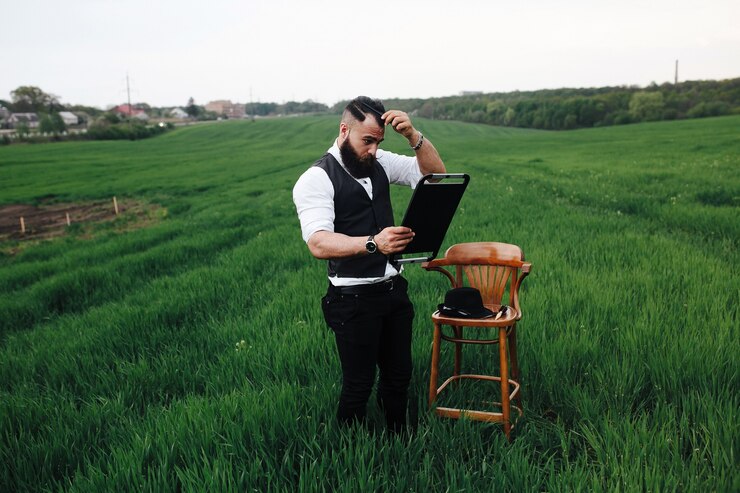Conventional farming data as soon as shaped the spine of agricultural communities, guiding every little thing from find out how to put together the soil to the very best instances of yr to prune orchard timber. At present, horticulture and agriculture are within the midst of profound change. Local weather fluctuations, the introduction of latest plant varieties, evolving shopper expectations, and technological instruments have all shifted the way in which fruit timber are grown, maintained, and distributed. But, woven by this altering panorama is a thread of older, time-honoured data. Whereas many fashionable growers now flip to superior irrigation methods or soil sensors, they nonetheless depend on concepts handed down by generations in relation to understanding how climate, soil composition, and biodiversity work together. This interaction of previous and current makes clear that though expertise has introduced nice advances, conventional strategies nonetheless have a important function to play.
In line with one nursery specialist at CRJ FruitTrees, the retention of tried-and-tested orchard practices is way from being an outdated sentiment. They stress that heritage strategies can inform higher decision-making, particularly in unpredictable rising seasons. These long-standing strategies, they are saying, have proved repeatedly that understanding the plant’s pure rhythms, together with the encompassing surroundings, is commonly simpler than any synthetic shortcut. They counsel that whereas novices dashing to purchase fruit timber would possibly concentrate on essentially the most sturdy, fashionable cultivars, the astute grower nonetheless finds knowledge within the outdated methods. By embracing this steerage—one which has labored for hundreds of years—gardeners can guarantee their orchards are more healthy, extra resilient, and higher in a position to deal with quite a lot of stressors. They add that clients who search to harmonise newer horticultural improvements with established, earthy traditions usually tend to see balanced development and style the complete sweetness of their backyard’s potential.
The Historic Foundations of Agricultural Knowledge
Lengthy earlier than the onset of synthetic fertilisers, mechanised instruments, or international provide chains, agriculture depended largely on what may very well be found by shut statement and lived expertise. Historical orchardists and small-scale farmers invested immense time into understanding how native ecosystems labored. They recognised that every piece of land had its personal character, formed by microclimates, slope, soil sort, water sources, and native natural world. They mapped the altering seasons, famous the presence of useful bugs, studied patterns of pests, and catalogued which crops thrived in shade versus direct daylight. Over generations, this holistic strategy shaped a physique of sensible data that was examined consistently. If a selected pruning approach constantly led to more healthy apple yields, it was remembered. If making use of sure natural mulch or rotating sure cowl crops helped keep soil fertility, it too grew to become a part of the accrued knowledge handed down by oral custom and cautious demonstration.
This sort of studying functioned as a dwelling library. A grandfather would possibly train his grandchild find out how to graft a department or choose essentially the most useful understock for grafting specific fruit timber, guaranteeing that the data survived. In rural communities, gatherings and harvest festivals weren’t simply social occasions however alternatives to share, evaluate, and refine strategies. Every success or failure added a brand new chapter to an agricultural story that prolonged by time. This affected person accumulation of trial and error allowed orchard keepers and gardeners to grasp the fragile steadiness wanted to supply dependable yields whereas preserving the long-term well being of the land.
Conventional Data in a Trendy Context
At present, fast globalisation and the tempo of change in horticulture would possibly counsel that older strategies are dropping relevance. But, when confronted with unpredictable local weather occasions—late frosts, summer time droughts, or uncommon pest invasions—fashionable orchardists more and more flip to those historic insights. In lots of circumstances, conventional data provides one thing extremely invaluable on this period of mechanisation: adaptability. Whereas equipment can carry out duties with nice effectivity, it can’t modify instinctively to sudden shifts in climate or adjustments within the soil’s microbe inhabitants. Human instinct and reasoning, knowledgeable by time-honoured knowledge, can pivot plans immediately, planting at a unique time of yr or selecting totally different help vegetation to push back encroaching illnesses.
Trendy gardeners, whether or not they handle giant orchards or have a tendency small dwelling gardens, usually discover that mixing custom with up to date science creates a a lot richer toolkit. Superior climate forecasts would possibly warn of a coming chilly snap, however it’s the orchardist’s ingrained data that means wrapping younger trunks in hessian or spreading a protecting mulch on the proper second. Laboratory analyses would possibly point out a nutrient deficiency within the soil, however the orchardist’s eye, educated by ancestral strategies, can interpret delicate leaf color adjustments or patterns within the undergrowth that assist information the treatment.
Strategies and Strategies Passing the Take a look at of Time
The continuity of sure farming practices proves their enduring value. Strategies corresponding to crop rotation, cautious grafting of fruit tree varieties, and the usage of pure predators for pest management haven’t grow to be out of date; somewhat, they’ve discovered a renewed objective. Conventional pruning strategies, as an example, stay integral to managing fruit timber’ form, publicity to daylight, and total vigour. Regardless of the provision of latest pruning instruments and mechanised shears, the ideas guiding how and when to prune stay comparatively in keeping with what orchardists did centuries in the past. The truth that fashionable textbooks and horticultural pointers echo these outdated approaches is testomony to their reliability.
One other space during which older strategies persist is in water and soil administration. Natural mulches, composting, and inexperienced manures, all important strategies in conventional gardening, are actually embraced by fashionable advocates of sustainable agriculture. Pure mulches not solely add vitamins to the soil but in addition assist regulate moisture ranges, cut back competitors from weeds, and keep a secure root surroundings. These strategies are grounded in a holistic understanding that depends on nurturing dwelling soil ecosystems somewhat than merely feeding the vegetation. Whereas artificial fertilisers have their place, the deeper perception that more healthy soil results in more healthy timber finally originated within the custom of cautious statement and stewardship.
Biodiversity and Soil Well being: Classes from the Previous
One of the urgent fashionable issues in horticulture and agriculture is the lack of biodiversity and declining soil well being. Conventional data, which at all times seen the orchard or backyard as a part of a broader ecological tapestry, provides important classes right here. Older farming practices hardly ever operated in isolation from the encompassing surroundings. Companion planting, the encouragement of useful bugs, and the usage of sure herbs and flowers to repel pests or encourage pollinators all replicate an understanding that nature works finest in steadiness. Historical orchardists revered that fruit timber thrived in a system teeming with life—microorganisms, earthworms, beetles, bees, and birds—all contributing to a delicate equilibrium.
On this period of chemical interventions, many growers have begun to return to those strategies. Though fashionable science explains why these approaches work when it comes to chemistry, biology, and ecology, the precept stays the identical: once you respect the surroundings’s pure cycles, you harness a pressure of resilience. Sustaining numerous groundcover vegetation might help cut back erosion, enhance water infiltration, and keep soil construction. Together with wildflower strips can help useful predators that handle insect pests with out chemical sprays. These concepts are usually not new however somewhat a reaffirmation of historic instincts {that a} wholesome orchard is greater than only a assortment of timber. It’s an interdependent group.
Preservation of Heritage Varieties in Trendy Nurseries
Regardless of market tendencies to streamline fruit manufacturing right into a handful of extremely productive, disease-resistant varieties, there’s a rising curiosity in preserving and cultivating heritage fruit tree varieties. Nurseries that concentrate on these older cultivars present a hyperlink to the previous, guaranteeing that particular flavours, distinctive resistances, and long-standing traits are usually not misplaced in a rush towards uniformity. A youthful orchardist deciding to purchase fruit timber at present is perhaps shocked to seek out that these heritage alternatives convey richer tastes, delicate textures, and aromas which were loved for hundreds of years.
The selection to maintain these older varieties alive is greater than a nod to nostalgia. It acknowledges that resilience is commonly present in genetic range. A fruit tree from a neighborhood heritage selection could also be higher tailored to the area’s particular local weather, extra tolerant of sure illnesses, or extra environment friendly at utilising the native soil’s vitamins. Trendy strategies permit for the propagation and distribution of those varieties extra effectively than up to now. But their worth rests on the time-honoured data that fastidiously chosen genetics, handed down by orchardist lineages, have real ecological and gastronomic value. By looking for out nurseries that curate such collections, these trying to purchase fruit timber can contribute to preserving agricultural traditions whereas including depth and character to their orchards.
Embracing Trendy Sources Whereas Honouring Custom
At present, orchardists and gardeners profit from an unprecedented availability of data. Web sites, books, cellular apps, and on-line boards provide fast insights on planting distances, really useful cultivars, pruning schedules, and extra. Laboratories can analyse soil in methods unimaginable in earlier centuries, recommending exact nutrient amendments to realize optimum plant well being. Precision irrigation methods present water in actual quantities on the proper instances. Greenhouses and polytunnels lengthen seasons and shield susceptible varieties. These improvements have elevated effectivity, predictability, and yield for a lot of growers.
Nonetheless, integrating these instruments successfully usually requires the tempering affect of conventional data. Strategies which have guided orchard administration for generations be sure that expertise shouldn’t be misapplied. Soil evaluation would possibly inform a grower that the bottom is low in phosphorus, however an skilled orchardist additionally is aware of from custom find out how to enrich the soil organically and progressively, guaranteeing that the treatment suits into the orchard’s long-term well being plan. Equally, whereas expertise can detect moisture ranges in real-time, it might nonetheless be the orchardist’s seasoned instinct that recognises a deeper signal of plant stress, prompting adjustments in care that no algorithm may counsel.
The important thing lies to find a steadiness. Trendy orchardists can honour centuries of accrued data by combining it with up to date understanding. The place superior pruning saws facilitate cleaner cuts, making use of them in step with outdated pruning strategies ensures that the tree is formed respectfully, following its pure development patterns. The selection to combine each paths not solely enhances plant well being but in addition creates a extra fulfilling expertise for growers. Those that recognize the historical past and craft behind their work are sometimes higher stewards of their land and happier of their pursuits.
Sustainable Practices and Moral Sourcing
Sustainability has grow to be a central concern, and older traditions have a fantastic deal to show fashionable growers about find out how to keep agricultural methods with out exhausting sources. Earlier than international provide chains and mass manufacturing, farmers needed to keep the long-term viability of their soils and guarantee ongoing fertility. This was achieved by strategies corresponding to utilizing compost, rotating crops, sustaining hedgerows, and inspiring useful organisms within the soil. None of those insights originated in a scientific laboratory; they emerged from necessity, affected person statement, and a profound respect for the pure world.
As shoppers grow to be extra conscious of the origins of their meals, nurseries and orchardists who nonetheless respect these ideas might discover themselves . Consumers usually search for fruit that has been grown ethically, with a low environmental footprint. They might additionally search alternatives to purchase fruit timber themselves from sources dedicated to sustainable strategies, together with heritage varieties that help better biodiversity. In each circumstances, conventional data informs the way in which these timber are propagated, raised, and delivered to the patron.
Moral sourcing additionally consists of recognising that older data can come from many alternative cultures and communities. Farmers from varied areas have tailored orchard strategies to their particular climates and terrains. Amassing, sharing, and respecting this data can result in improvements that serve fashionable wants whereas preserving a worldwide heritage of concepts. As local weather change threatens to change rising situations drastically, the orchard traditions of areas which have discovered to deal with harsh or unpredictable climate will grow to be ever extra invaluable.
Navigating Cultural Shifts and Shopper Calls for
Shopper demand adjustments quickly, formed by well being developments, aesthetic preferences, and shifting culinary pursuits. But the orchard stays ruled by elementary ideas that don’t change practically as quick. The natural processes of development, blossoming, pollination, and fruiting nonetheless comply with patterns established lengthy earlier than fashionable shopper markets existed. Conventional data reminds orchardists that no advertising innovation or fashionable new cultivar can override the essential wants of vegetation and soil.
This isn’t to say that custom stifles innovation. Quite, it offers a measure of stability and continuity. As orchardists reply to new calls for for distinctive fruit flavours, improved vitamin, or uncommon varieties, they’ll depend on acquainted strategies to make sure their experiments align with pure rhythms. The orchard has at all times been an area of experimentation, however it’s the underlying framework of inherited knowledge that retains these experiments grounded in actuality. Growers who know their land intimately—as a result of they’ve noticed it intently for years and have constructed upon ancestral insights—usually tend to produce constant high quality, whilst they adapt to shoppers’ evolving tastes.
Neighborhood Involvement and the Passing On of Data
The continued relevance of conventional farming data additionally depends on how nicely it’s handed on to the following era. Whereas formal training in horticulture or agriculture might help be sure that novices study the fundamentals, really mastering the orchard usually requires interpersonal mentorship. Elders can reveal delicate strategies, corresponding to find out how to prune to realize the precise cover form for solar penetration, or find out how to detect the presence of illness earlier than it turns into apparent. The apprentice advantages not solely from technical talent but in addition from the ethos of stewardship and respect that underpins these strategies.
In communities the place this passing of information continues to be practised, youthful growers develop a wealthy understanding that goes past manuals and information sheets. They kind a respect for the orchard as a dwelling system, one which exists each within the second and as a part of a convention that connects the previous to the longer term. This sense of continuity is invaluable, particularly in a world the place so many elements of life really feel in flux. The orchard turns into a repository of identification and tradition, a spot the place the outdated methods and new strategies meet, guaranteeing that future generations will nonetheless know find out how to have a tendency the land responsibly and productively.
Trendy communication instruments can truly improve this custom. Digital conferences, movies, and on-line tutorials imply that older orchardists can share insights with learners far past their native area. This broad dissemination of information would possibly result in surprising collaborations and hybrids of custom, the place somebody discovering find out how to purchase fruit timber in a single a part of the nation can apply pruning ideas gleaned from the expertise of orchard keepers in one other. Over time, this international data trade would possibly spawn new traditions, mixing native knowledge with strategies borrowed from distant lands.
Dealing with Environmental Challenges
As climates shift and environmental pressures intensify, farmers face an unsure future. Floods, droughts, and heatwaves take a look at even essentially the most resilient orchards. Right here, conventional data performs an more and more very important function. Historical strategies of water conservation, shade administration, and pollinator help grow to be greater than quaint customs; they’re important instruments for sustaining productiveness in a altering surroundings. The orchardist who respects these outdated methods shouldn’t be clinging to nostalgia however somewhat arming themselves with confirmed options.
Many of those strategies have been developed exactly as a result of growers up to now confronted their very own challenges—typically harsher or much less understood than these of at present. They discovered find out how to create windbreaks, enhance drainage, or encourage pure insect predators not only for aesthetics however to make sure survival. Their successes and failures present a historic blueprint that helps fashionable orchardists reply extra successfully. Pairing this inherited knowledge with at present’s scientific developments and local weather modelling permits a extra nuanced strategy to threat administration, guaranteeing that orchards stand a greater probability of remaining productive and sustainable within the many years to return.
The Timeless Attraction of the Orchard
A part of the enchantment of orchard traditions is that they join folks to an easier, extra secure previous. Even those that stay in city environments or depend on grocery store cabinets for his or her fruit nonetheless recognize the notion of a well-tended orchard, brimming with blossoms in spring and laden with fruit in summer time and autumn. Gardens and orchards remind folks of seasonal rhythms and pure cycles that city life usually obscures. There’s a psychological consolation in figuring out that sure issues—corresponding to the very best instances to plant sure varieties, or the cycles of fertility within the soil—don’t change merely as a result of human life do.
When people select to purchase fruit timber, they usually achieve this for causes past productiveness. They need to reconnect with nature, style fruit that they’ve grown themselves, and play an element in sustaining conventional strategies that maintain the earth wholesome. By doing so, they grow to be a part of a lineage of orchardists who’ve, over numerous generations, discovered to learn the delicate clues nature offers and reply accordingly. This timeless enchantment ensures that, irrespective of how superior horticultural science turns into, there’ll at all times be a spot for conventional farming data in shaping how fruit timber are grown.
Conclusion: A Timeless Useful resource for Future Generations
The function of conventional farming data in fashionable orchard administration is each enduring and evolving. As local weather challenges mount, shopper tastes shift, and expertise turns into ever extra subtle, it may appear as if the orchardist’s reliance on older knowledge would fade. As a substitute, the alternative is true. Conventional strategies present a stabilising affect, a repository of examined insights that no quantity of recent gadgetry can absolutely substitute.
From guiding sustainable soil administration to influencing the choice of heritage varieties, from providing resilient methods to dealing with environmental stresses to nurturing a respectful strategy to biodiversity, conventional farming data is woven into each side of the orchard. Trendy growers and their clients profit from this mix of outdated and new, experiencing richer tastes, more healthy ecosystems, and a stronger connection to the land and its historical past.
So long as folks proceed to have a tendency fruit timber, recognize the subtleties of their development and flavour, and try to work in concord with nature’s rhythms, conventional data will stay a significant a part of the method. When fashionable orchardists search steerage, they discover knowledge cast by centuries of statement. Whether or not they put money into cutting-edge irrigation methods or just comply with ancestral recommendation to prune at a selected time of yr, they’re collaborating in a dynamic custom. A lot has modified in agriculture, but the orchard endures as a spot the place outdated data nonetheless guides new fingers. By means of all of it, growers who select to purchase fruit timber and combine conventional farming data into their follow will proceed to reap the rewards—plentiful harvests, sustainable strategies, and a dwelling reference to a wealthy agricultural heritage.









